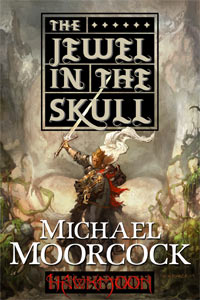I remember finding my first Michael Moorcock books at a used bookstore in downtown Palo Alto back in the early 70s. I was very young, of course. (So was Michael, I’m sure—a precocious youth. None of us wants to be reminded how long we’ve been writing.)
I don’t remember if the Hawkmoon books were the first or the second thing of his I read. I know that I went through the Elric, Corum, and Hawkmoon books all in short order after I discovered them, and then began systematically tracking down everything else of Moorcock’s I could find, occasionally even splurging on a new paperback instead of waiting for one to show up pre-owned. That was the mark of true love.
What I do remember, however, is falling into Moorcock’s Multiverse in the most complete sort of way. I was enthralled with scope of it and amused by its funhouse mirror aspects, the way characters who were obviously different versions of each other kept showing up and the funny ways in which they were related. This was the Eternal Champion mythology, part of which is center stage in The Jewel in the Skull and its successors in the person of Dorian Hawkmoon, who is an incarnation (for lack of a better word) of Moorcock’s metaversally recycled Champion. But it was also the way Moorcock’s minor characters and locations kept popping up too in different form that charmed me from the first. In fact, this fascination with refracted characters and situations has become a major part of my own work, and whether I use it because Moorcock influenced me so deeply or he influenced me because I was already so attracted to these kind of ideas is truly moot: his work blew my teenage mind and it has never been unblown.
In later years I was fortunate enough to meet Mike Moorcock and count him as a friend, but the strange thing is that no matter how many times I’ve spoken with him, broken bread with him, or even written stories set in his universes to share with him, there’s still a part of me frozen in that time almost forty years ago now, prowling the used science-fiction shelves hoping for one more Elric, one more, Hawkmoon, or even an elusive Urlik Skarsol. The fact that I know him now makes me feel like a luckier version of myself from some other part of the Multiverse. (I guess I’ll always be a Moorcock fanboy at heart.)
Which brings me to the Hawkmoon books and this latest edition of The Jewel in the Skull. One of the reasons that my fanboy nature has never entirely gone away is that, unlike some authors I loved at the same age, Moorcock has always been far more than a mere writer of adventure fiction. Leaving out his “literary” novels and his more experimental (and more horrifying and amusing) works like the Jerry Cornelius books, Moorcock even in his earliest work still managed to catch readers by surprise. The evil Granbretanian Empire of the Hawkmoon books works on many different levels, both as purely frightening melodrama villains and as a comment on the most noxious sorts of British politicians. I dare anyone who suffered through the last days of the Thatcher/Major regime not to recognize Moorcock’s prescient characterizations of the worst sorts of English reactionary thuggishness.
(Of course, thugs like these are common to all cultures and all countries, so whatever your personal experience, you’ll recognize something similar to the worst you’ve seen.)
And the Empire of Granbretan itself is a marvelous creation, a combination of the worst parts of all modern empires, whether science fictional or real—technology-obsessed, heartless, greedy, lacking the most basic loyalty even between the thieves and bullies who pull the levers.
There are so many things to discover and enjoy in the Hawkmoon books, not least of which are the heroic but unassuming nature of Hawkmoon himself—he’s much less self-pitying than some of Moorcock’s other protagonists, despite having plenty to feel sorry for himself about—and the wonderful cast of supporting characters, bold Count Brass and fastidious D’Averc, the scholar Bowgentle and Oladahn the tiny giant, and of course Hawkmoon’s beloved Yisselda (who’s a pretty kick-ass fighter, as many of Moorcock’s sword-and-sorcery heroines are.)
And of course the wonderfully horrible Granbretanians, King Huon (who’s really, really creepy) and his chief warrior, wolf-masked Meliadus (this relationship quite neatly prefigures George Lucas’s Emperor/Vader paradigm of a few years later) as well as all the other monstrous villains with their grand names and hideous animal masks, piggy Shenegar Trott, Taragorm (who wears a grandfather clock), Adaz Promp, Mygel Holst, and Jerek Nankeensen, master of the Order of the Fly… I loved them all. You will too if you love adventure and ideas. The generation before us had Tarzan and Professor Challenger, but we had the Eternal Champion, Dorian Hawkmoon and all his splendid incarnations.
?Go read the Hawkmoon books, starting with The Jewel in the Skull. Moorcock was just learning to spread his wings when he wrote them, but already his wingspan dwarfed most other writers in the field. And of course, many of us writing today still work (and do so very happily) in the shadow of those wings.
Tad Williams is the bestselling author of several fantasy and science fiction novels, including Tailchaser’s Song, the Memory, Sorrow, and Thorn series, the Shadowmarch series, the Otherland series, and The War of the Flowers, as well as the Ordinary Farm YA series, which he writes with his wife Deborah Beale.










